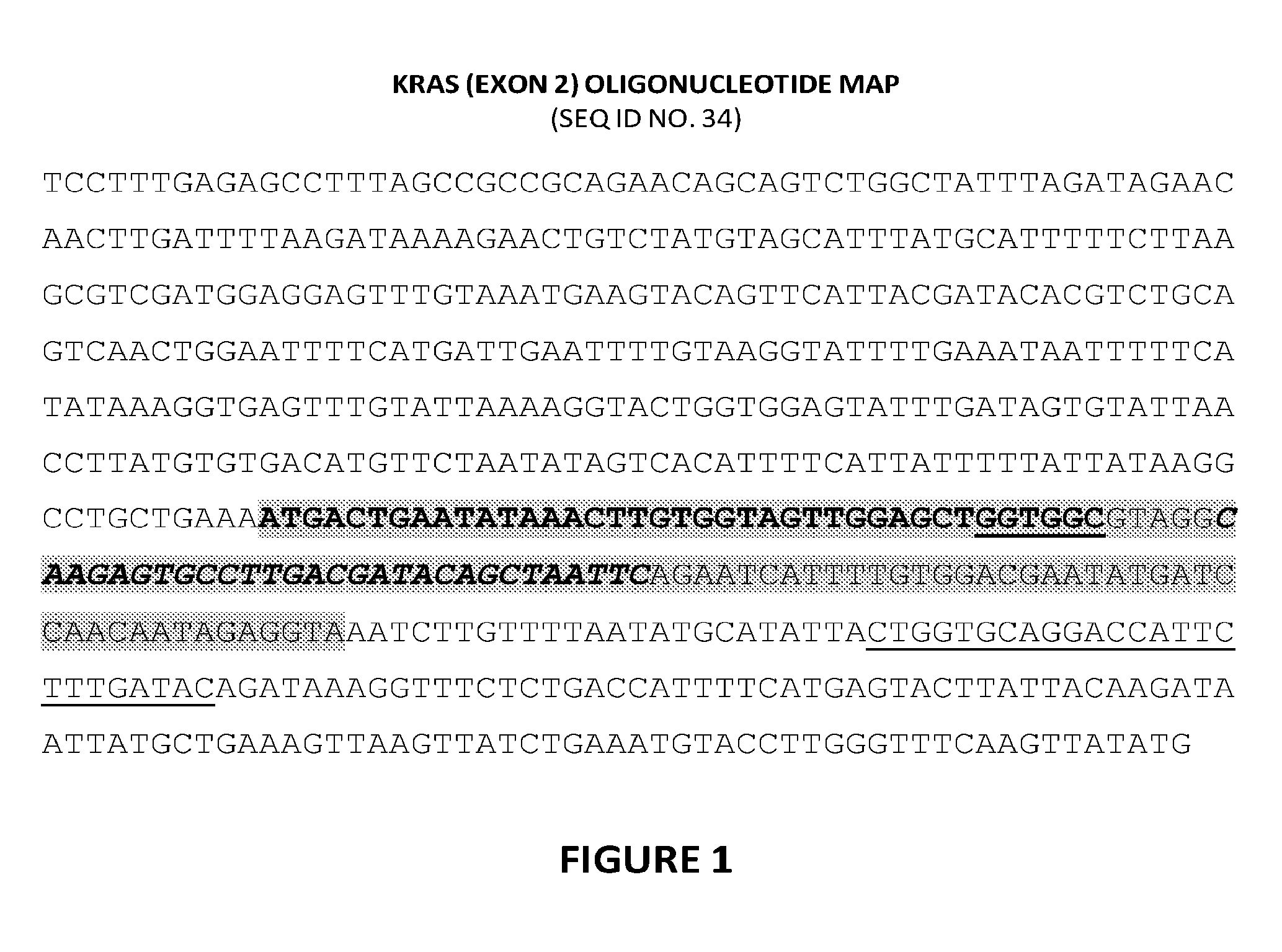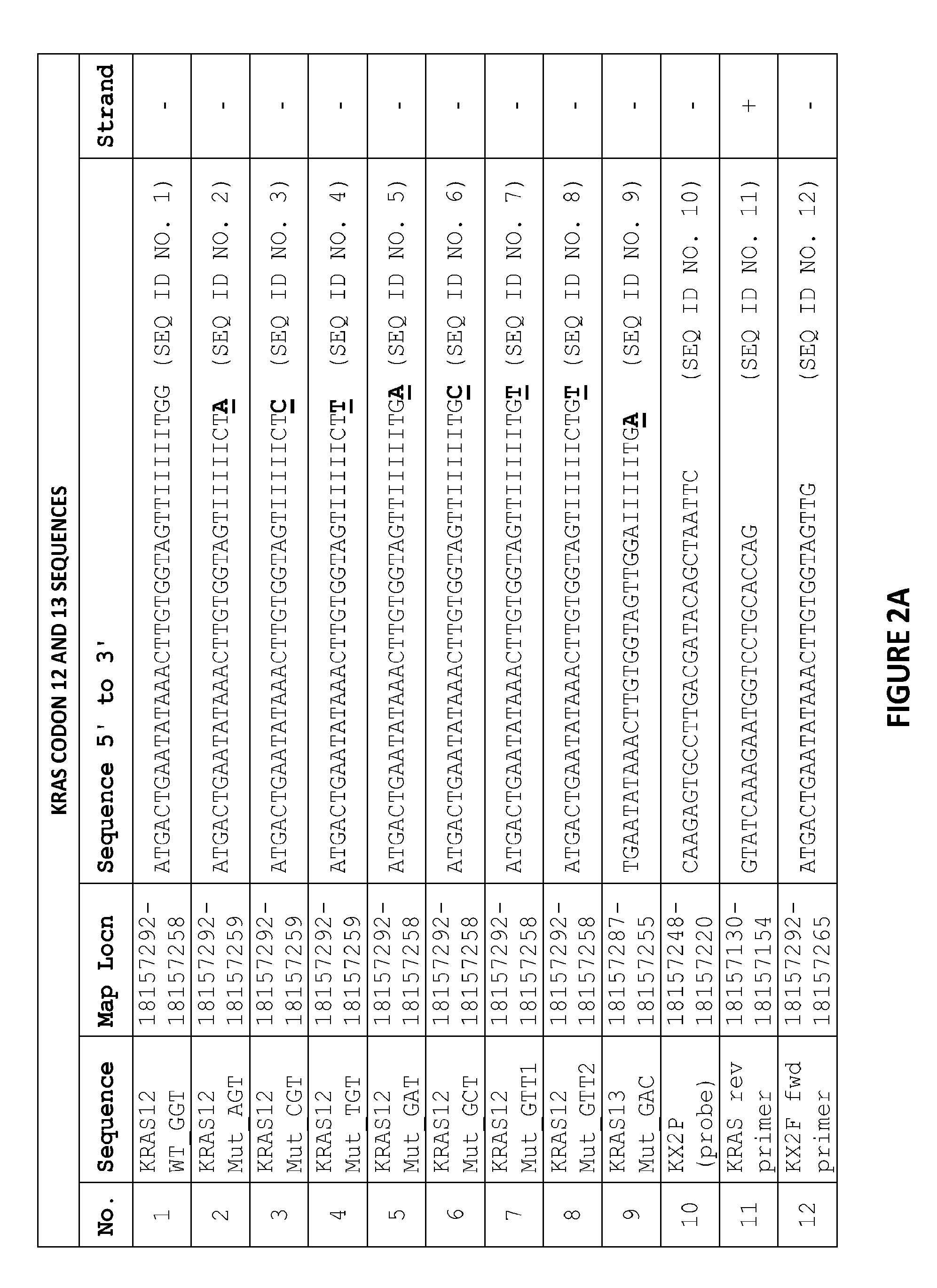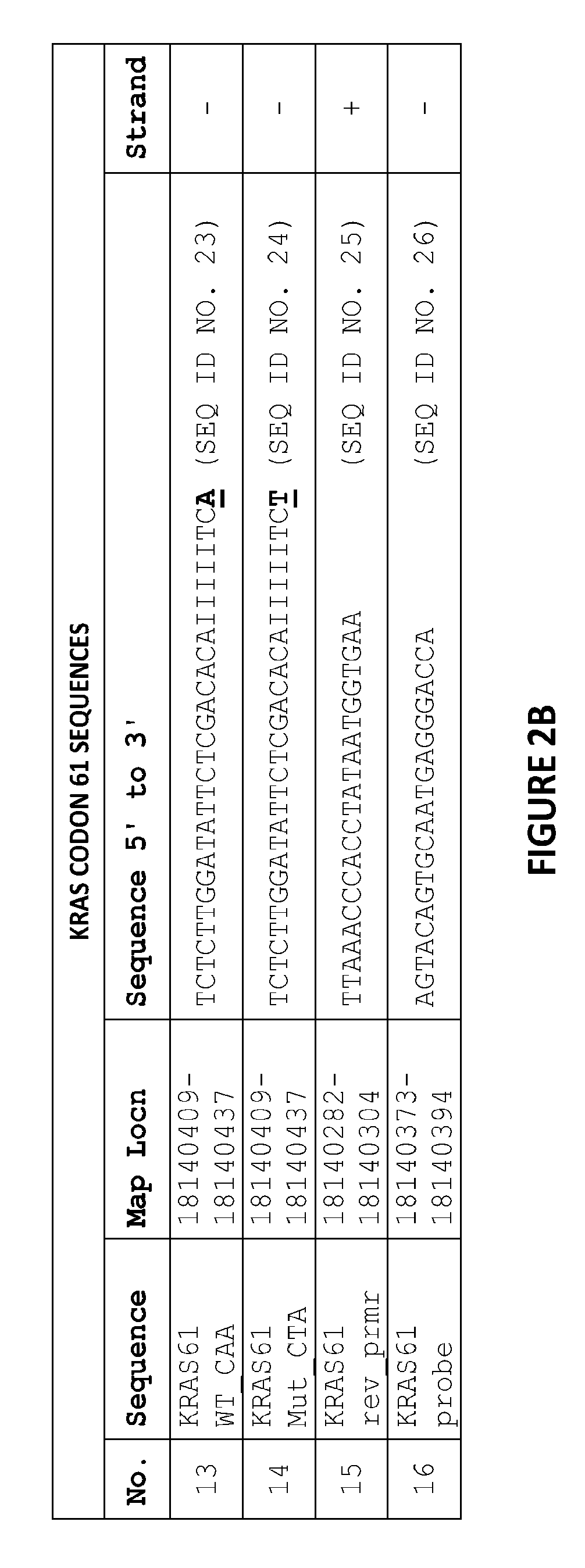Oligonucleotides and methods for detecting KRAS and PIK3CA mutations
a technology applied in the field of oligonucleotides and methods for detecting kras and pik3ca mutations, can solve the problems of inability to detect direct sequencing, inability to detect in the absence of kras and pik3ca, etc., to achieve high specificity and sensitivity
- Summary
- Abstract
- Description
- Claims
- Application Information
AI Technical Summary
Benefits of technology
Problems solved by technology
Method used
Image
Examples
example 1
Location of KRAS kPCR Genotyping Assay Primers and Probes
[0082]NCBI Accession No. NT—009714.16 / Hs12—9871 was used to extract the KRAS genomic sequences.
[0083]The sequence in FIG. 1 shows the fragment of the KRAS genomic DNA cloned into a pCR II vector and used for quantifying KRAS DNA in samples. The location and design of the primer and probe candidates in the codon 12 and 13 KRAS kPCR Genotyping Assay are indicated on the sequence of FIG. 1 as follows:
[0084]The gray shaded region of the sequence is KRAS exon 2.
[0085]The bold underlined region of the sequence (ggtggc) is the location of KRAS codons 12 and 13.
[0086]The bold non-italicized area of the sequence (including the underlined region of the sequence) shows the location of the forward primers, including all wild-type and genotype-specific primers.
[0087]The bold italicized area of the sequence shows the location of the probe.
[0088]The unbolded underlined area of the sequence shows the location of reverse primer.
[0089]FIG. 2A i...
example 2
KRAS (Conon 12 and 13) kPCR Genotyping Assay Set-Up
[0093]The singleplex assay was set up with eight individual kPCR reaction mixes that were each loaded in one of the 8 rows of a 96-well plate. The reaction mixes contained PCR buffer, magnesium chloride, deoxyribonucleotide triphosphates, reference dye-ROX, specific oligonucleotides, fluorescence labeled oligonucleotide probe, and nuclease-free water. The Taq DNA polymerase was added to each reaction mix at the time of the assay. The following assays were run: KRAS codon 12 and 13 wild-type assays, all six KRAS codon 12 mutation assays (Gly12Ser, Gly12Arg, Gly12Cys, Gly12Asp, Gly12Ala, Gly12Val) and one codon 13 mutation assay (Gly13Asp).
[0094]The controls for each run included a contamination control (negative control), 100% KRAS codon 12 and 13 wild-type control (4 ng / uL), and one well of each of the six KRAS codon 12 mutations and the one KRAS codon 13 mutations, each diluted 1:100 in a background of KRAS codon 12 and 13 wild-typ...
example 3
Sensitivity of the KRAS kPCR Genotyping Assay
[0102]The experiment described herein was conducted to establish assay sensitivity and specificity confidence. The experiment included optimizing the KRAS kPCR Genotyping Assay wild-type / mutant signal threshold and evaluating the assay sensitivity and specificity confidence using the optimized kPCR wild-type / mutant signal threshold.
[0103]The following two representative KRAS codon 12 mutants were examined: Gly12Val (GGT>GTT) and Gly12Ser (GGT>AGT). 5 μL of each sample was loaded in 8 wells and tested by 8 target specific master mixes.
[0104]Genomic DNA was extracted from cell cultures carrying sequences of wild-type (G1y12) and Gly12Val and Gly12Ser mutants. Genomic extracts were initially quantified by absorbance spectrophotometry then diluted to 20 ng / A. The dilution accuracy of each extract was verified by a second optical density photospectrometry quantitation. KRAS copy number for each cell line was calculated by quantitating 100 ng o...
PUM
| Property | Measurement | Unit |
|---|---|---|
| Tm | aaaaa | aaaaa |
| Tm | aaaaa | aaaaa |
| concentrations | aaaaa | aaaaa |
Abstract
Description
Claims
Application Information
 Login to View More
Login to View More - R&D
- Intellectual Property
- Life Sciences
- Materials
- Tech Scout
- Unparalleled Data Quality
- Higher Quality Content
- 60% Fewer Hallucinations
Browse by: Latest US Patents, China's latest patents, Technical Efficacy Thesaurus, Application Domain, Technology Topic, Popular Technical Reports.
© 2025 PatSnap. All rights reserved.Legal|Privacy policy|Modern Slavery Act Transparency Statement|Sitemap|About US| Contact US: help@patsnap.com



